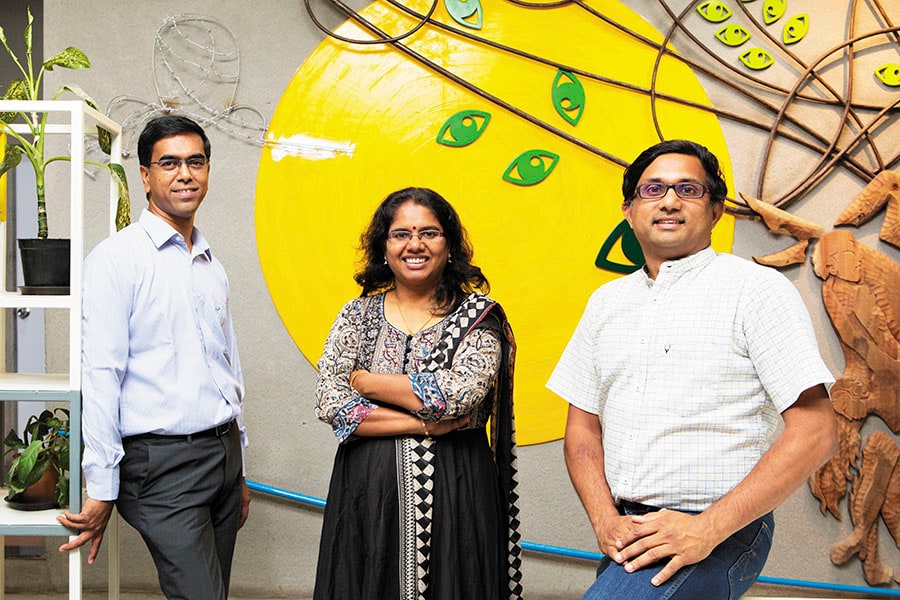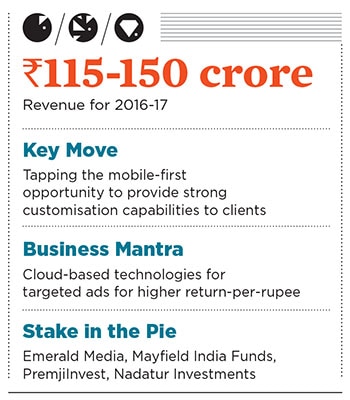
Amagi Media Labs: Beam me here, Scotty
Founded by Baskar Subramaniam, Srinivasan KA and Srividhya Srinivasan, the firm helps enterprises and media platforms target ads to local audiences
 (From left) Co-founders Srinivasan KA, Srividhya Srinivasan and Baskar Subramaniam
(From left) Co-founders Srinivasan KA, Srividhya Srinivasan and Baskar Subramaniam
Image: Selvaprakash Lakshmanan for Forbes India
Imagine you are a small business with a product that you want to sell in your home district. You probably don’t have the budget for a prime-time ad slot on a national broadcaster, and, in any case, the ad is wasted outside your home market. But you do want that premier slot to reach your target audience. How do you straddle the two?
This is where Amagi Media Labs’ geotargeting solution—in which national broadcasters can beam different ads locally—comes into play. A concept pioneered by Baskar Subramaniam, Srinivasan KA and Srividhya Srinivasan, Amagi does this through a combination of hardware and software that integrate with broadcasters’ networks and beam the right ad to the right location. So an audience in Bengaluru will see a different ad from those in, say, Chandigarh.
As cloud infrastructure gets more sophisticated, Amagi, which was founded in 2008 and went commercial the next year, anticipated the shift to digital. Now, with its own cloud network, it is not only helping enterprises target specific markets, but also broadcasters customise content to multiple countries.
The people behind it
When the co-founders launched Amagi, advertisers would release a lot of information and hope that the audience would be able to separate the wheat from the chaff. That worked for deep-pocketed companies looking for pan-India visibility, but not smaller enterprises eyeing a regional market.
“When we looked at geotargeting, we wanted to do individual targeting, (but) we thought the country had neither the need nor the infrastructure for it,” says Subramaniam. With the proliferation of smartphones that ecosystem has changed.
Before Amagi, the trio had a successful exit at Impulsesoft, in Bengaluru, which they co-founded (along with K Srikrishna, who, after Impulsesoft, started a venture of his own), and worked on communications engineering technologies. They worked at SiRF Technologies, which bought Impulsesoft, for a couple of years before starting Amagi.
The three ploughed in their own money—about $500,000, including from Impulsesoft’s sale—but was soon backed by venture capitalist NS Raghavan around mid-2010. He contributed to a later round as well, totalling close to $7 million. Amagi’s other investors include Emerald Media, a KKR-backed fund, Mayfield India Funds and PremjiInvest.

Today, Amagi is the leader in cloud-managed broadcast services and targeted advertising for TV and OTT (over the top, where TV content is delivered to standalone screens via the internet). Its technologies have been deployed in over 40 countries and the company delivers more than 80 feeds to global audiences. It has offices in New York, London, Hong Kong, and a broadcast innovation lab in Bengaluru.
With $30 million in Series D funding, raised earlier this year, the next stop for the entrepreneurs is Artificial Intelligence and personalised ads—customisation, both for the businesses and for end consumers.
Mayfield, the first institutional investor for Amagi, put in its money in 2013. “What impressed us was that they were disrupting a proven market: The advertising market in India and the global media market in general. What Facebook has done on the internet by targeting the individual user for advertisement, Amagi has done that to television broadcasting,” says Vikram Godse, managing partner, Mayfield India.
For instance, Amagi has enabled Sun TV to broadcast Tamil content in Singapore. Sun could not do it earlier as they had to spend around $1 million to get a satellite to broadcast its content in the island-nation. By using the technology created by Amagi, Sun TV can now bypass satellites and save about 75 percent of the cost.
Typical of companies that pioneer a new technology or business model, Amagi had to contend with a long gestation period before growth would kick in. The company is estimated to have earned between ₹115 crore and ₹150 crore in 2016-17, and is yet to break even. That said, Amagi is now primed to take advantage of geo-location based ads served on mobile devices as well. In the US alone, the market for such ads is nearly $30 billion, according to market researcher BIA Kelsey.
“Geotargeting of advertising on national television hasn’t been done anywhere in the world. India, with its demographics, was ideally suited for this technology,” says Atul Gupta, a principal at PremjiInvest, which first invested in Amagi about three years ago, and also in the latest funding round. Amagi’s technologies have gone mainstream on Zee Networks, and soon will be launching on a few more national networks, Gupta said.
While one part of the business targets the domestic market, a second caters to networks beaming programming from India to other countries, and to overseas broadcasters beaming to multiple countries, including India. This vertical is growing strongly, Gupta says. Companies are now more focussed on the per-rupee impact, making Amagi’s technologies more relevant than ever. It will only rise as the world becomes “mobile first” and businesses seek greater accuracy in targeting specific groups for ads. “Amagi’s products can completely change the game,” says Gupta.
Risks and challenges
Amagi faces its biggest challenge from broadcasters who think the company is trying to “unbundle” national pricing, and from large broadcasters building their own solutions, such as Star India’s—a unit of 21st Century Fox—AdSharp, launched in 2014.
Gupta argues that worrying about ‘unbundling’ isn’t the way to approach the changes in advertising today. Businesses, from automakers to FMCG companies, are overhauling their ad spends, skewed more and more towards online, and away from television broadcasting, for instance. And Amagi’s technology is “extremely pertinent” for broadcasters if they have to keep up with the change.
(With inputs from Pravin Palande)
(This story appears in the 30 November, -0001 issue of Forbes India. To visit our Archives, click here.)





